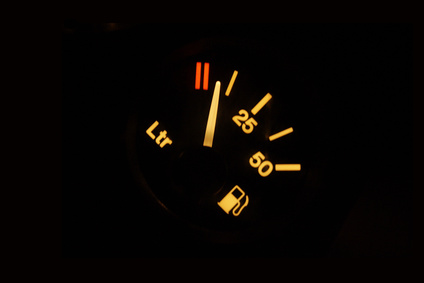
The fuel injectors on your 2002 Chevy Trailblazer are part of the fuel-injection system that mixes fuel with air in the engine. Fuel-injection systems have replaced carbureted systems almost completely since the 1980s. The injector itself is the nozzle, or valve component, that operates in conjunction with the fuel pump to deliver fuel to the engine. A bad or dirty injector can lead to poor fuel economy, a sputtering engine or weak and intermittent engine firing.
Relieve the fuel system pressure by first removing the fuel filler cap and then the fuel pump relay, located in the fuse box under the hood. Start the engine and allow it to stall, then continue to crank the engine an additional five to 10 seconds.
Disconnect the negative battery cable from the terminal.
Remove the intake manifold by first removing the throttle body and PCM. Disconnect the electrical harnesses from their brackets and the MAP sensor connector. Disconnect the front differential vent hose from its bracket clip. Disconnect the crankcase vent hose from its port on the manifold. Remove the engine harness bracket and alternator. Disconnect the vacuum hose from the power brake booster and then remove the intake manifold by unscrewing the bolts.
Clean the fuel rail/fuel injector area with degreaser. Blow the area dry with compressed air.
Disconnect the fuel pressure regulator vacuum line, the fuel injector harness connector and the fuel line fittings. Remove the fuel rail attaching bolts and apply gentle and even outward pressure on the fuel rail to free it from the cylinder head.
Disconnect the electrical connector from the injectors to be removed. Remove the retaining clips and remove the injectors from the fuel rail assembly. Remove and discard the O-rings and seals (two per injector).
Replace the injector O-rings. Apply a light coat of clean engine oil to the O-rings and press the injector into the fuel rail until seated. Install the injector retaining clips.
Inspect the injector holes on the cylinder head and clean out if necessary. Lubricate the injector seal O-rings with clean engine oil and seat them on the injector holes. Reconnect the electrical connector to the injector.
Replace the fuel rail assembly and tighten the mounting bolts to 89 in-lbs.
Continue with the installation in the reverse of removal. Once complete, turn the ignition switch to "On" but do not engage the starter. Cycle the ignition on and off several times to activate the fuel pump and build fuel pressure. Check the fuel lines, fuel rail and injector for leakage prior to full operation.
Relieve the fuel system pressure by first removing the fuel filler cap and then the fuel pump relay, located in the fuse box under the hood. Start the engine and allow it to stall, then continue to crank the engine an additional five to 10 seconds.
Disconnect the negative battery cable from the terminal.
Remove the air intake duct and resonator by removing the diagonal brace and intake baffle. Loosen the captive screws and pull the housing cover up, then lift the air filter element out of the housing. Disconnect the headlamp washer hose and the electrical connectors for the windshield washer, headlamp washer, fluid level and water pump. Disconnect the forward lamp harness clips and washer fluid hose. Remove the housing mounting nuts and remove the housing.
Disconnect any electrical connectors that will interfere with fuel rail removal. Detach the upper engine wiring harness from the retainers and position the wiring harness aside. Disconnect the accelerator cable and cruise control cable from the throttle body. Detach the cables from the bracket and position the cables aside.
Clean the fuel rail/fuel injector area with degreaser. Blow the area dry with compressed air.
Disconnect the fuel injector electrical connectors by pulling the retainer up and pushing in on the tab. Tag each connector with a number that corresponds to the cylinder number. Disconnect the fuel supply and return lines from the fuel rail pipes. Disconnect the fuel vacuum line from the fuel pressure regulator.
Remove the fuel rail mounting bolts. Loosen the crossover tube retaining screw at the passenger side of the fuel rail but do not remove the tube. Gently rock the fuel rail and injectors to loosen the injectors. Remove the fuel rail and fuel injectors as an assembly.
Remove the retaining clip and remove the injectors from the fuel rail assembly with a forked tool. Remove and discard the O-rings and seals.
Replace the injector O-rings and apply a light coat of clean engine oil. Press the injector into the fuel rail until seated. Install the injector retaining clips.
Install the injector and fuel rail assembly on the intake manifold and fully seat the injectors. Apply a thread-locking compound to the fuel mounting bolts and tighten them to 89 in-lbs. Tighten the crossover tube retainer screw at the right fuel rail.
Connect the fuel supply and return lines; verify they are securely installed. Connect the electrical connectors to each injector according to the number as tagged.
Continue with the installation in the reverse of removal. Once complete, turn the ignition switch to "On" but do not engage the starter. Cycle the ignition on and off several time to activate the fuel pump and build fuel pressure. Check the fuel lines, fuel rail and injector for leakage prior to full operation.